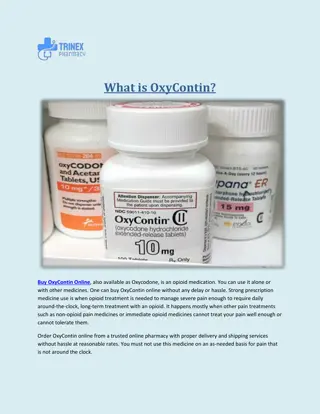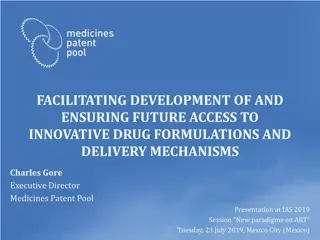Enhancing Access to Medicines and Health Products through Innovative Approaches
Global Health Centre experts discuss how building access into innovation can ensure better access to medicines, vaccines, and health products. Key ideas include planting seeds for access early in innovation, exploring alternative innovation models, and rethinking the relationship between innovation and access.
Download Presentation

Please find below an Image/Link to download the presentation.
The content on the website is provided AS IS for your information and personal use only. It may not be sold, licensed, or shared on other websites without obtaining consent from the author.If you encounter any issues during the download, it is possible that the publisher has removed the file from their server.
You are allowed to download the files provided on this website for personal or commercial use, subject to the condition that they are used lawfully. All files are the property of their respective owners.
The content on the website is provided AS IS for your information and personal use only. It may not be sold, licensed, or shared on other websites without obtaining consent from the author.
E N D
Presentation Transcript
Building Access into Innovation: Why, How, Where? Building Access into Innovation: Why, How, Where? Virtual Expert Workshop on Key Challenges and New Developments in Ensuring Access to Medicines, Vaccines and other Health Products, 16 February 2024 Session 2: New developments and solution pathways in addressing key challenges, thus ensuring and enhancing access to medicines, vaccines and other health products Suerie Moon & Adri n Alonso Ruiz Global Health Centre, Graduate Institute of International and Development Studies, Geneva suerie.moon@graduateinstitute.ch
Building access into Innovation: 3 key ideas Building access into Innovation: 3 key ideas Why?: Seeds for access should be planted in earliest stages of innovation 1. How?: 2. Where?: 3.
Rethink relationship between innovation and access Rethink relationship between innovation and access Alternative pharmaceutical innovation model Mainstream pharmaceutical innovation model Innovation balanced against access Innovation with access Image sources: https://associationsnow.com/2015/04/talking-tech-balancing-it-security/; https://www.amazon.com/Garden-Decoration-Natural-Septuple-Stacked/dp/B0093QN1IK
Building access into Innovation: 3 key ideas Building access into Innovation: 3 key ideas Why?: Seeds for access should be planted in earliest stages of innovation 1. How?: Alternative innovation models 2. Where?: 3.
Alternative innovation models can differ in one or more characteristics from mainstream models, including the organization s: Mission: e.g. equity, health impact, joint profit and health goals Organizational form: e.g. nonprofit, public benefit corporation Financing: e.g., mixed private and public, philanthropic or social impact investor funding Priority-setting: e.g., unmet health need Role in different phases of the R&D process: e.g., academic institutions conducting later-stage development Knowledge management: e.g., open science, public and private collaboration, data sharing, no patenting, non-exclusive licensing, or participating in patent pools Regulatory strategy: e.g., active collaboration with regulator; prioritizing developing country regulators Manufacturing strategy: e.g., small scale, collaborative agreements Distribution: e.g., prioritizing disease-endemic developing countries Pricing: e.g., affordability caps, limited profit, tiered pricing, competition Home country: e.g., low- or middle-income, international network
Database of Alternative Innovation Initiatives RE:ROUTE, A map of the alternative biomedical landscape (Kiddell-Monroe, Greenberg and Basey, 2016) n=41 Non-commercial R&D: What do neglected diseases suggest about costs and efficiency? (Vieira M, Kimmit R and Moon S., 2021) n = 30 Neglected Diseases Rare Diseases Antibiotics Others Microbiome transplant(FMT bank) Psychedelic-mediated therapy Biosimilar production Pandemic Preparedness Internal knowledge, literature synthesis, non-systematic online searches n = 48 Snowballing n = 11 Source: Database of Alternative R&D Initiatives. Available: https://www.knowledgeportalia.org/database-of-alternative-r-d-initiatives
Example: Open science network: Baylor Covid-19 vaccine Baylor College of Medicine researchers develop Covid-19 vaccine using established protein technology with small-scale philanthropic funding Offer patent-free candidate vaccine with data, technology transfer to any interested LMIC producers Biological E (India): conducts clinical trials, production, registration: 84 million doses administered in India for adolescents Biofarma (Indonesia): halal vaccine, 10 million doses administered
Building access into Innovation: 3 key ideas Building access into Innovation: 3 key ideas Why?: Seeds for access should be planted in earliest stages of innovation 1. How?: Alternative innovation models 2. Where?: Growing innovative capacity in low- and middle-income countries 3.
From 2010- 20, number of trials in LMICs increased by 375%. Source: Vieira et al (2023). Rising pharmaceutical innovation in the Global South: a landscape study | Journal of Pharmaceutical Policy and Practice | Full Text (biomedcentral.com)
2022 snapshot: A global system of Covid-19 vaccine R&D Developer Top 10 trial locations US Development stage Number of candidates HICs LMICs HICs+LMIC 1 35 2 China 32 Pre-clinical 199 55% 39% 6% 3 Australia 21 4 Brazil 16 Clinical 172 53% 41% 6% 5 Japan 13 Total in 371 6 South Africa 12 7 Canada 11 development Germany 9 8 Indonesia 9 Iran 8 Total approved 50 9 South Korea 8 Turkey 8 Argentina 7 India 7 Russia 7 10 Thailand 7 UAE 7 UK 7 Source: Luana Bermudez data analysis for the Global Health Centre. Data sources: WHO and LSHTM Covid-19 vaccine trackers
Building access into Innovation: 3 key ideas Building access into Innovation: 3 key ideas Why?: Seeds for access should be planted in earliest stages of innovation 1. How?: Alternative innovation models 2. Where?: Growing innovative capacity in low- and middle-income countries 3. Conclusions: 1. Making medicines globally-accessible by design is possible through alternative innovation models Alternative innovation models can be expanded through: Greater political, financial and legal support Experimentation International networks of cooperation 2.
Thank you Learn more at: https://www.knowledgeportalia.org/
Resource: Knowledge Prior public domain Internal Technology Transfer External in-licensing External open science Resource: Funding Public Philanthropic Private impact investors Priority-review voucher Revenues (sales, licensing, services) Resource: Manufacturing In-house Spin-offs Partnerships Outsourcing (CMOs) Organizational Form: Academic Foundation National government agency Intergovernmental organization Public benefit corporation Public private product development partnership Private not-for-profit company Private for-profit company Practices: Knowledge Management: Open access publishing Open source drug discovery No IP rights Ownership of IP rights Licensing with conditions Practices: Transparency R&D costs Production costs Contract/license terms Practices: Pricing Affordability in product design Donation Subsidized price Cost-plus price Preferential price Tiered price Practices: Availability Designed for resource-limited settings Local production/tech transfer Registration/distribution in endemic countries Community engagement Ingredients Menu
3 Archetypes: Soup, Sandwich or Salad? Sandwich Salad Soup Open science network National Public Sector Public- private partnership National public institution sets priorities to reflect national needs, finances and facilitates R&D Open collaborative knowledge flows, networks of actors perform different R&D stages or tasks Public and/or philanthropic priority-setting, financing to private firms for public goal Academic, NGOs also involved Private actors may also be involved but do not drive R&D Largely academic, public sector, non-profit actors, with some private firms + Draw on range of capabilities + Political support sustains public financing, demonstrated success + Rapid scientific advance, range of capabilities - Voluntary, hard to align public and private interests, relies on donors - Unclear coordination, unclear financing - Neglects global needs & opportunities, suitability varies by country
Mainstream innovation model A commercial profit-maximizing firm conducts at least the later stages of R&D (e.g., pre- clinical to clinical trials) and brings a product to market. Market incentives and competition between companies influence: Financing: profit-maximizing investors, revenues from product sales Priority-setting: profitable diseases or technologies Knowledge management: data kept confidential, IP used to block competitors from using knowledge Regulatory strategy: in most profitable markets Production: profit-maximizing production strategy, subject to quality requirements Marketing: significant investment to promote product uptake Distribution: to profitable markets Pricing: profit-maximizing price what market or price regulator will bear Usually, this firm is based in a high-income country
Meat, Soup, Sandwich or Salad? Sandwich Salad Soup Open science network National Public Sector Public- private partnership Mainstream commercial Pandemic prep Pandemic prep Pandemic prep Neglected disease Neglected disease Neglected disease Rare diseases Rare diseases Antibiotics Antibiotics























